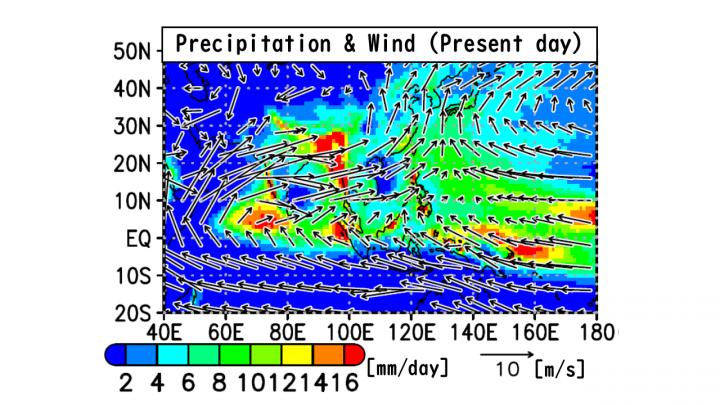Wetter than wet: Global warming means more rain for Asian monsoon regions

Map of current rainfall (mm day-1) and wind (m s-1). Vectors show wind in the lower troposphere. The tropical monsoon region lies upwind of Japan. Credit: Tokyo Metropolitan University
Researchers from Tokyo Metropolitan University studied how the weather will change with global warming in Asian monsoon regions using a high-resolution climate simulation. The region is home to a large population, and the monsoons are a major driver of global water cycles.
They explicitly simulated cloud formation and dissipation, and found significantly increased precipitation over the monsoon “trough,” with tropical disturbances such as typhoons and concentrated water vapor playing key roles.
As the world braces itself for the impact of global warming, it is now more vital than ever to have an accurate, detailed picture of how exactly the climate will change.
This applies strongly to the Asian monsoon regions, where vast amounts of annual precipitation make it an important part of global energy and water cycles. As home to a large proportion of the world population, detailed, local predictions for the scale and nature of monsoons and tropical disturbances such as typhoons/cyclones have the potential to inform disaster mitigation strategies and key policymaking.
A team led by Assistant Professor Hiroshi Takahashi sought to address this by using a high-resolution climate model known as NICAM (Non-hydrostatic ICosahedral Atmospheric Model) to study the detailed evolution of weather in the Asian monsoon regions.
The model's key strength is an explicit account of cloud formation and dissipation based on physical principles e.g. accounting for the convective effects that give rise to cumulonimbus clouds and subsequent precipitation when the air pressure drops. This level of detail allowed the team to study future precipitation patterns due to Asian monsoons with unprecedented accuracy.
The team's simulation of 30 years of global warming shows significantly elevated levels of precipitation in the monsoon “trough,” a zone spanning northern India, the Indochina peninsula, and the western parts of the North Pacific. It is well known that global warming leads to more precipitation, driven mostly by more water vapor in the atmosphere.
However, the different features of each region mean that the changes are far from uniform. For example, the study found that it was not clear whether “monsoon westerlies” were enhanced, but it did find more cyclones in the trough, enough to account for the increased precipitation. Concurrent with the increased precipitation, they also found distinct trends in water vapor over the monsoon region.
Furthermore, the team focused on the effect of sea surface temperature. Previous studies often applied a global, uniform increase in temperature plus the regional variations created by the El Nino effect. To separate their effects, they added them separately in two independent simulations, concluding that it was the former, a global increase in sea surface temperature, that contributed most strongly to the increased precipitation.
The effects of the monsoon season in Asia can be devastating. Examples include locations close to home for the team e.g. the 2018 and 2020 floods in western Japan and the East Asian countries. With these region-specific findings, their work may play an important role in global disaster mitigation, infrastructure development and policy decisions.
###
This work was partly supported by JSPS KAKENHI Grant Number 19H01375, the Environment Research and Technology Development Fund (JPMEERF20192004) of the Environmental Restoration and Conservation Agency of Japan, and Japan Aerospace Exploration Agency (JAXA) EO-RA2 (PI number: ER2GPF012). This work was also partly supported by MEXT as “Program for Promoting Researches on the Supercomputer Fugaku” (Large Ensemble Atmospheric and Environmental Prediction for Disaster Prevention and Mitigation). All the simulations were performed using the K computer at the RIKEN R-CCS (Proposal number hp120279, hp130010, and hp140219).
Media Contact
More Information:
http://dx.doi.org/10.1175/JCLI-D-19-0824.1All latest news from the category: Earth Sciences
Earth Sciences (also referred to as Geosciences), which deals with basic issues surrounding our planet, plays a vital role in the area of energy and raw materials supply.
Earth Sciences comprises subjects such as geology, geography, geological informatics, paleontology, mineralogy, petrography, crystallography, geophysics, geodesy, glaciology, cartography, photogrammetry, meteorology and seismology, early-warning systems, earthquake research and polar research.
Newest articles

Superradiant atoms could push the boundaries of how precisely time can be measured
Superradiant atoms can help us measure time more precisely than ever. In a new study, researchers from the University of Copenhagen present a new method for measuring the time interval,…

Ion thermoelectric conversion devices for near room temperature
The electrode sheet of the thermoelectric device consists of ionic hydrogel, which is sandwiched between the electrodes to form, and the Prussian blue on the electrode undergoes a redox reaction…

Zap Energy achieves 37-million-degree temperatures in a compact device
New publication reports record electron temperatures for a small-scale, sheared-flow-stabilized Z-pinch fusion device. In the nine decades since humans first produced fusion reactions, only a few fusion technologies have demonstrated…





















